
High-visibility clothing, sometimes shortened to hi vis or hi viz, is any clothing worn that is highly luminescent in its natural matt property or a color that is easily discernible from any background. It is most commonly worn on the torso and arm area of the body. Health and safety regulations often require the use of high visibility clothing as it is a form of personal protective equipment.[1][2][3] Many colors of high visibility vests are available, with yellow and orange being the most common examples. Colors other than yellow or orange may not provide adequate luminescence for conformity to standards such as ISO 20471.
As a form of personal protective equipment, high-visibility clothing is worn to increase a person's visibility and therefore prevent accidents caused by persons not being seen. As a result, it is often worn in occupations where hazardous situations are created by moving vehicles or low lighting conditions. These occupations include railway and road workers, airport workers and emergency services. Cyclists and motorcyclists may also use high-visibility clothing to increase their visibility when operating amongst motor traffic.[4] Hunters may be required to wear designated high-visibility clothing to prevent accidental shooting.
Effectiveness
Motorcyclists
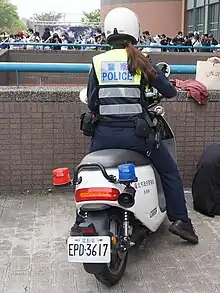
The Hurt Report found that very few motorcyclists involved in collisions wore high-visibility clothing, and that just over half of the collisions studied, nearly two-thirds of those involving another vehicle, were due to the motorist unintentionally violating the motorcyclist's right of way. "This dominant culpability of the driver of the other vehicle... emphasizes the special need for high contrast conspicuity for the motorcycle and rider."[5]
A New Zealand case-control study found that the population attributable risks were 33% for wearing no reflective or fluorescent clothing; one third of motorbike accidents might have been prevented by wearing high-visibility clothing. Conspicuous behaviors, such as the wearing of high-visibility clothing, the use of headlights in the daytime, and the use of a white helmet, reduced the risk of a rider facing a collision.[5]
Cyclists
Traffic risks to the cyclist are similar to those faced by motorcyclists, with the main differences being that cyclist speeds are typically lower, and the cyclist wears less protective gear. In a 2009 study, most UK cyclists and almost all motorists believed that high-visibility clothing would increase cyclists' visibility. Almost all drivers agreed that cyclists need to wear reflective clothing in low lighting environments, whereas less than three-quarters of cyclists (72%) agreed, and less than half claimed that they always did so.[6]
A Cochrane Systematic Review of research evidence for the effectiveness of visibility aids (fluorescent and retroreflective clothing and equipment) was carried out by Kwan and Mapstone in 2006.[7] The authors found 42 studies which collectively suggested that fluorescent clothing could increase the distance at which drivers could detect and then recognise cyclists in daylight conditions.[7] The same review found evidence that retro-reflective materials worn by cyclists at night had a similar effect on driver perceptions. At that time there were no studies published that had actually demonstrated a reduction in collision crashes for bicyclists wearing fluorescent or retroreflective clothing whilst on public roads.

A 2009 Australian study of drivers trying to see stationary cyclists on a closed circuit found that fluorescent vests (without retro-reflective stripes) were not a significant improvement on black clothing at night and that retro-reflective strips were more effective when attached to knees and ankles than on a more or less static jacket.[8]
A 2012 British case-control study showed a non-significant increase in the odds of a crash for users of reflective conspicuity aids whilst cycling.[9] In 2014, a further case-control study conducted in Canada reported a decrease in the odds of a collision with a motor vehicle when wearing 'light' coloured (not specifically fluorescent) clothing in daylight but an increase in the odds of a collision for cyclists using fluorescent clothing (and lights) at night. The number of conspicuity aids used was positively associated with an increase in collision crash odds but a non-significant reduction in the likelihood of hospitalisation.[10]
A randomized controlled trial was conducted in Denmark between 2012 and 2013.[11] The study collected data from 6793 regular cyclists for a year.[11] The results suggest that conspicuity enhancing jackets can reduce by 47% the risk of collisions with other road users that cause injury and 55% for those collisions involving a motor vehicle.[11] The effect of the intervention was higher in winter compared to summer (56% vs 39%), in daylight (51% vs the overall effect 47%) and for those participants who reported 'high' use of the jackets vs 'low' use (60% vs 33%).[11] The study was based on participants self-reporting data, and there was evidence of response bias, which the authors attempt to correct for, reducing the 47% figure to 38%.[11]
Since April 2013, New York City regulations require commercial cyclists, such as restaurant delivery persons or bike messengers, to wear high visibility clothing while riding.[12]
Rail workers in the United Kingdom
.jpg.webp)
Experimental use of high-visibility clothing began in 1964 on the Scottish Region of British Railways.[13] Fluorescent orange jackets, known as "fire-flies", were issued to track workers on the Pollokshields to Eglinton Street electrified section in Glasgow;[14] they were later tried in other areas, such as Edinburgh, Aberdeen and Inverness. Train drivers operating in these areas were asked their opinion as to the effectiveness of the jackets.[13] Following trials, high-visibility clothing was issued to engineering and other staff working on the electrified lines of the London Midland Region of British Railways in 1965. It was thought to be more important due to the higher speeds of the newly electrified West Coast Main Line route from London Euston to Birmingham, Manchester and Liverpool. The first version was worn as a jerkin and was "visible at ... half a mile in normal weather conditions".[15]
Since then, features of high-visibility clothing such as the EN510 quick release standard and the EN471 and its successor EN ISO 20471:2013 high visibility standards, have improved the effectiveness and contributed to improved safety for rail workers and other staff.[16] The specifications for Rail Industry Standard RIS-3279-TOM (fluorescent orange) high-visibility clothing suitable for use on railways in the United Kingdom are published by the Rail Safety and Standards Board.[17]
Standards

EN ISO 20471:2013 (Europe/ISO)
RIS-3279-TOM (UK Rail Industry Standard)
ANSI/ISEA 107-2015 (USA)
AS/NZS 4602.1:2011 (Australia)
India
The latest Indian standards for High Visibility Warning Clothes - Specification is IS 15809 : 2017.
ANSI/ISEA
The American National Standards Institute published standard 107 [18] for high-visibility clothing in 1999. The standard defines three classes of successively more-visible garments, to protect workers exposed to successively higher levels of risk from motor vehicles and heavy equipment. The International Safety Equipment Association developed the standard, with revisions in 2004, 2010 and 2015.[19][20][21]
The 207 standard has different requirements for fluorescent background material, specifically allowing for a shorter design that allows equipment belt access. It also includes many optional features, such as a 5-point breakaway design for easy removal, panels readily identifying the wearer as an emergency responder, and radio and badge holders.[22]
Regulation (EU) 2016/425
A European Union directive which covers high-visibility clothing.[23]
North American hunting regulations

Hunting laws in each state or province may require hunters to wear designated garments in blaze orange to prevent misidentification of humans as game animals, and resulting shooting accidents. The required total visible area and times of use vary by jurisdiction and by the type of hunting in the area. Hunting clothes are available in blaze orange camouflage, where the bright orange color is plainly visible to human eyes, but the shape of the hunter is broken up by irregular patterns to prevent identification as a threat by game animals such as deer, who cannot see the color.[24] Some jurisdictions also allow the use of a "blaze pink," a color that proponents argue is both more visible to humans and less visible to game animals.[25]
ISO 20471
The International Organization for Standardization published standard ISO 20471 for high-visibility clothing in 2013.[26][27]
Australia
Australian/New Zealand Standard - AS/NZS 4602.1:2011 High visibility safety garments Garments for high risk applications from Standards Australia.
Part 1: Garments for high risk applications - Sample of the standard.
Safe Work Australia - general Personal Protective Equipment guide including references to high visibility clothing
Class D workwear is suited to daytime use in Australia. [28]
Canada
Canadian Standards: Z96-15 - High-visibility safety apparel
Canadian Center for Occupational Health and safety (CCOHS): Guide High-Visibility Safety Apparel: "Requirements for high-visibility safety clothing for Canadian workers are found in the CSA Standard Z96-15 High-Visibility Safety Apparel".
Gallery
 Firefighters wearing coats with high-visibility strips
Firefighters wearing coats with high-visibility strips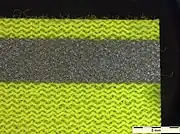 Retroreflective material in light microscope, magnification 3.5 ×
Retroreflective material in light microscope, magnification 3.5 ×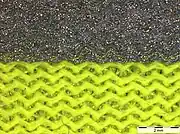 Retroreflective material in light microscope, magnification 8 ×
Retroreflective material in light microscope, magnification 8 × Retroreflective material in light microscope, magnification 20 ×
Retroreflective material in light microscope, magnification 20 ×- Retroreflective material in Scanning Electron Microscope, magnification 15 ×
- Retroreflective material in Scanning Electron Microscope, magnification 200 ×
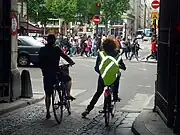 Reflective bag as used during the day in a dark area (illuminated by camera flash)
Reflective bag as used during the day in a dark area (illuminated by camera flash)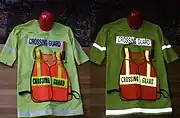 Photos of crossing guard clothing in normal light, and reflecting a point source of light.
Photos of crossing guard clothing in normal light, and reflecting a point source of light..jpg.webp) RCMP officers wearing reflective vests in Downtown Vancouver
RCMP officers wearing reflective vests in Downtown Vancouver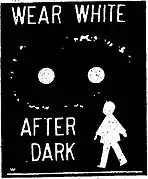 A 1979 public service advertisement from a Wisconsin newspaper
A 1979 public service advertisement from a Wisconsin newspaper
See also
- Safety yellow
- Chartreuse yellow (also called neon yellow)
- Display (zoology) – High-visibility in nature
- Retroglo
- Retroreflector
- Retroreflective sheeting
- Safety orange
- Yellow vests movement
References
- ↑ "Vehicles at work - High visibility clothing". www.hse.gov.uk. Retrieved 2021-02-03.
- ↑ "Fact Sheet: High-visibility Safety Apparel - Unraveled" (PDF). Oregon OSHA.
- ↑ "High Visibility Clothing for Heavy & Highway Construction" (PDF). American Road and Transportation Builders Association.
- ↑ "Rules for cyclists (59 to 82) - The Highway Code - Guidance - GOV.UK". www.gov.uk. Retrieved 2021-02-03.
- 1 2 3 Susan Wells; et al. (April 10, 2004). "Motorcycle rider conspicuity and crash related injury: case-control study". BMJ. 328 (7444): 857. doi:10.1136/bmj.37984.574757.EE. PMC 387473. PMID 14742349. Retrieved 2007-06-26.
- ↑ Wood, J.M.; et al. (2009). "Drivers' and cyclists' experiences of sharing the road: Incidents, attitudes and perceptions of visibility" (PDF). Accident Analysis & Prevention. 41 (4): 772–776. doi:10.1016/j.aap.2009.03.014. PMID 19540966.
- 1 2 Kwan I, Mapstone J. Interventions for increasing pedestrian and cyclist visibility for the prevention of death and injuries. Cochrane Database of Systematic Reviews 2006, Issue 4. Art. No.: CD003438. DOI: 10.1002/14651858.CD003438.pub2.
- ↑ Wood, Joanne M., Tyrrell, Richard A., Marszalek, Ralph P., Lacherez, Philippe F., Carberry, Trent P., & Chu, Byoung Sun (2011) Using reflective clothing to enhance the conspicuity of bicyclists at night. Accident Analysis and Prevention, 45(March), pp. 726-730. http://eprints.qut.edu.au/47281/1/ Archived 2014-02-01 at the Wayback Machine
- ↑ Miller, Phil (2012). The use of conspicuity aids by cyclists and the risk of crashes involving other road users: a population based case-control study (PhD). U. of Nottingham.
- ↑ Hagel, B.E.; Romanow, N.T.R.; Morgunov, N.; Embree, T.; Couperthwaite, A.B.; Voaklander, D.; Rowe, B.H. (2014). "The relationship between visibility aid use and motor vehicle related injuries among bicyclists presenting to emergency departments". Accident Analysis & Prevention. 65: 85–96. doi:10.1016/j.aap.2013.12.014. PMID 24445139.
- 1 2 3 4 5 Lahrmann, H.; Madsen, T.K.O.; Olesen, A.V.; Madsen, J.C.O.; Hels, T. (2017). "The Effect of a Yellow Bicycle Jacket on Cyclist Accidents". Safety Science. 108: 209–217. doi:10.1016/j.ssci.2017.08.001.
- ↑ Siff, Andrew (2013-02-22). "NYC to Crack Down on Food Delivery Cyclists". NBCNewYork.com. NBCUniversal. Retrieved 2017-10-24.
- 1 2 Cooke, B.W.C., ed. (July 1964). "Notes and News: "Fire-fly" jackets for men on the line". The Railway Magazine. Vol. 110, no. 759. Westminster: Tothill Press. p. 593.
- ↑ "News and Comment". Modern Railways. Vol. XIX. Shepperton: Ian Allan. June 1964. p. 373.
- ↑ Cooke, B.W.C., ed. (November 1965). "Notes and News: High visibility clothing". The Railway Magazine. Vol. 111, no. 775. London: Tothill Press. p. 668.
- ↑ "EN ISO 20471:2013" (PDF). XMSilverline. 2013. Retrieved 2019-05-19.
- ↑ "Rail Industry Standard for High Visibility Clothing" (PDF). Rail Safety and Standards Board. 2016. Retrieved 2017-04-02.
- ↑ "ANSI/ISEA 107-1999 American National Standard for High-Visibility Safety Apparel". eLCOSH. Retrieved 2007-08-26.
- ↑ "ANSI/ISEA 107-2004 MADE EASY: A Quick Reference to High-Visibility Safety Apparel". 3M. Retrieved 2007-08-26.
- ↑ "ANSI/ISEA 107-2015 MADE EASY: A Quick Reference to High-Visibility Safety Apparel" (PDF).
- ↑ "ANSI/ISEA 107-2015 MADE EASY: A Quick Reference to High-Visibility Safety Apparel" (PDF).
- ↑ "ANSI/ISEA 207-2006: American National Standard for High-Visibility Public Safety Vests". Promobm. December 13, 2019.
- ↑ "Regulation (EU) 2016/425 of the European Parliament and of the Council of 9 March 2016 on personal protective equipment and repealing Council Directive 89/686/EEC". April 21, 2018. Retrieved 2008-03-24.
- ↑ Gary Clancy Larry R. Nelson Hunting Whitetail Deer: Innovative Techniques for Any Situation Quayside, 2000 ISBN 1610602773 p.83
- ↑ Clarke, John. "Hunting In Hot Pink May Be Safer, But Some Men Resist. Maybe 'if I Was Stalking Flamingos.'". msn.com. The Wall Street Journal. Retrieved 5 December 2023.
- ↑ "ISO 20471:2013 - High visibility clothing -- Test methods and requirements". www.iso.org. Retrieved 2018-02-12.
- ↑ "EN ISO 20471:2013 High visibility clothing -- Test methods and requirements". issuu.com. 2016. Retrieved 2019-05-19.
- ↑ "Safety First: Hi Vis Standards for Australian Workwear". Total Image Group. 2022-04-12. Retrieved 2022-04-21.